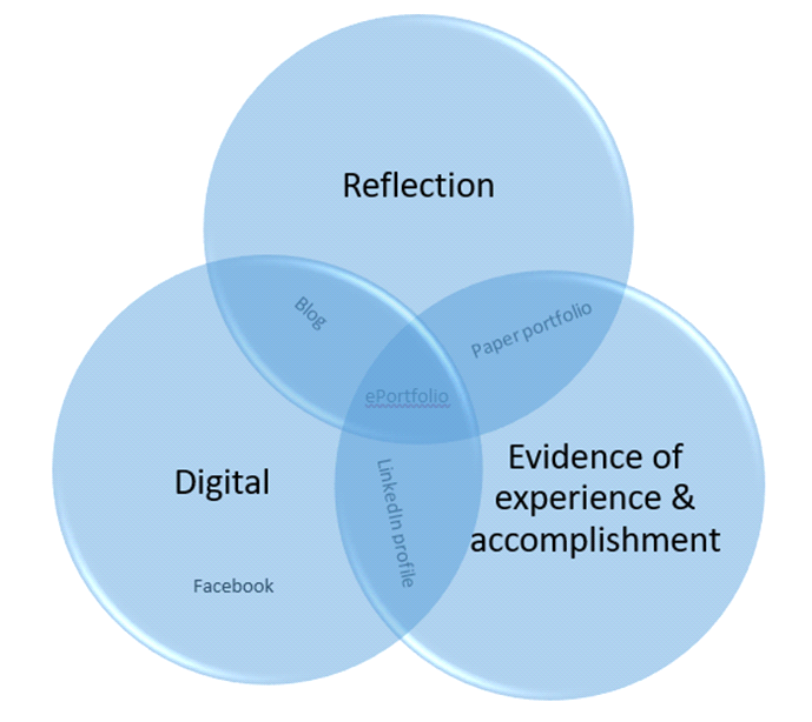Reflections
An ePortfolio provides students with an expanded digital presence. Although they have many other forms of digital presence, an ePortfolio can combine a digital presence with evidence of learning and reflective writing.

From Leveraging the eportfolio for integrative learning: a faculty guide to classroom practices for transforming student learning, by C. Reynolds and J. Patton, 2014, Stylus. An ePortfolio also can provide students with deeper learning when reflective writing is incorporated.
Faculty should understand that most students are not innately reflective writers. Reflection is a skill that needs to be developed. To assist to students in developing this skill, start students with simple and easy-to-answer reflection prompts and provide scaffolded support as they develop this skill.
Guiding principles of reflection
- Reflection is a meaning-making process that moves a learner from one experience into the next with deeper understanding of its relationships with and connections to other experiences and ideas. It is the thread that makes continuity of learning possible, and ensures the progress of the individual.
- Reflection is a systematic, rigorous, disciplined way of thinking.
- Reflection needs to happen in community, in interaction with others.
- Reflection requires attitudes that value the personal and intellectual growth of oneself and of others.
From “Defining Reflection: another look at John Dewey and reflective thinking,” by C. Rogers, 2002, Teachers College Record, 104(4), 845. Creating an audience and scaffolding If faculty assign reflection activities, it is important to read and provide support and feedback to students about their reflections. Students are typically not reflective by nature and therefore need scaffolding, a variety of instructional techniques used to move students progressively toward understanding and independence in the learning process. With scaffolding, faculty provide successive levels of temporary support to help students achieve higher levels of comprehension and skill acquisition. Scaffolding is incrementally removed when it is no longer needed, thereby shifting more responsibility for learning to the student. In addition to developing skills, scaffolding also reduces negative emotions and self-perceptions students experience when they get frustrated, intimidated, or discouraged when attempting a difficult task without the assistance or understanding. To provide students with feedback and to demonstrate exactly what is expected:
- Show students a reflective statement presented with a criteria chart or rubric. This can be done with reflections you wrote or exemplars from other students.
- Lead a discussion with students about how visual aids, pictures, and charts can augment a reflection statement.
- Use the think aloud method in which you model your thought process about developing a reflective statement.
- Ask students to share their own experiences and ideas about how the course content links to their previous knowledge and experience. Faculty may need to offer hints and suggestions that lead them to the connections.
- Provide students time to verbalize their thoughts as they work to make sense of connections between course content and their previous knowledge and experience.
- Use think-pair-share method; have each student read own reflection and jots notes about main points then discuss with another student and finally the pair reports to group
- Use one-minute reflections in which students write a brief reflection at the end of class/discussion that describes their thoughts before class/discussion, what they learned from others, and what they think now
- Incorporate asynchronous online peer feedback in which each student must provide a comment for each peer’s reflection statement
- Demonstrate different approaches to reflection such as a defining features matrix, a mind map, an inventory of learning, a word cloud, or a venn diagram.
Tips to get your students started
- Give students clear guidance with language they will understand and design/scaffolding that prompts them to focus on key issues and develop reflective skills
- Design backward
- Strike a balance by making it a regular part of the course but do not overwhelm them with reflections
- Vary your approach by changing up the type of reflection
- Make the connection between school work and personal life
- Build student’s learning mastery by helping students review their own learning strategies and identify what helped them succeed
- Feedback matters
Source: High-impact eportfolio practice: a catalyst for student, faculty and institutional learning, by B. Eynon and L.M. Gambino, 2017, Stylus
Make sure to use the best HTML CSS JavaScript tools to get the perfect code.